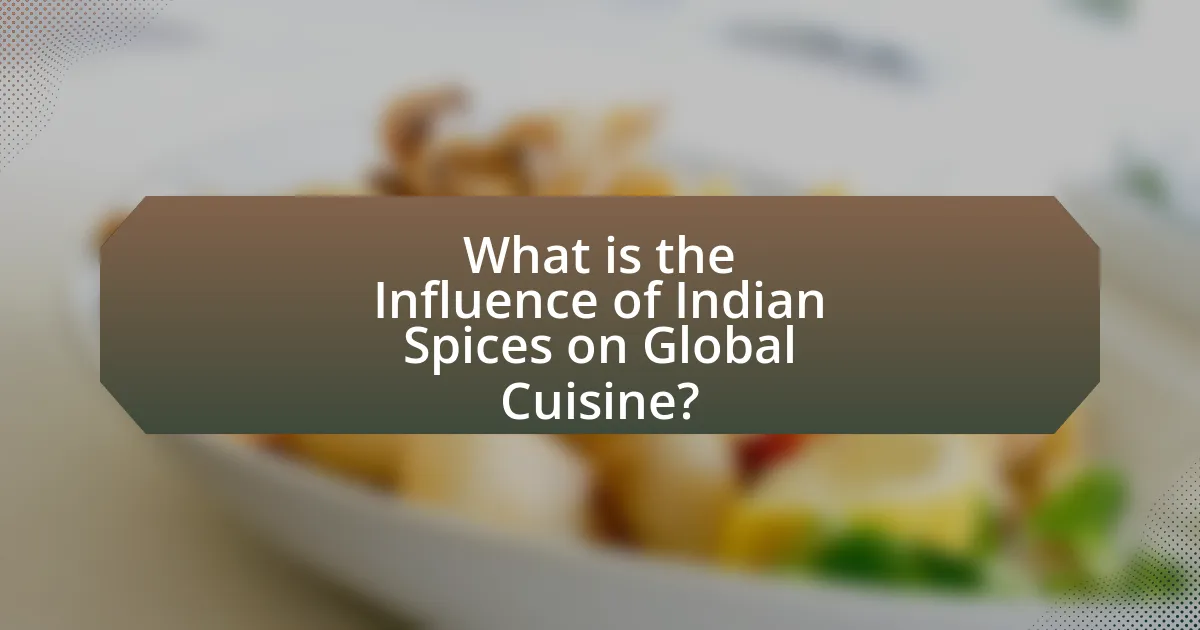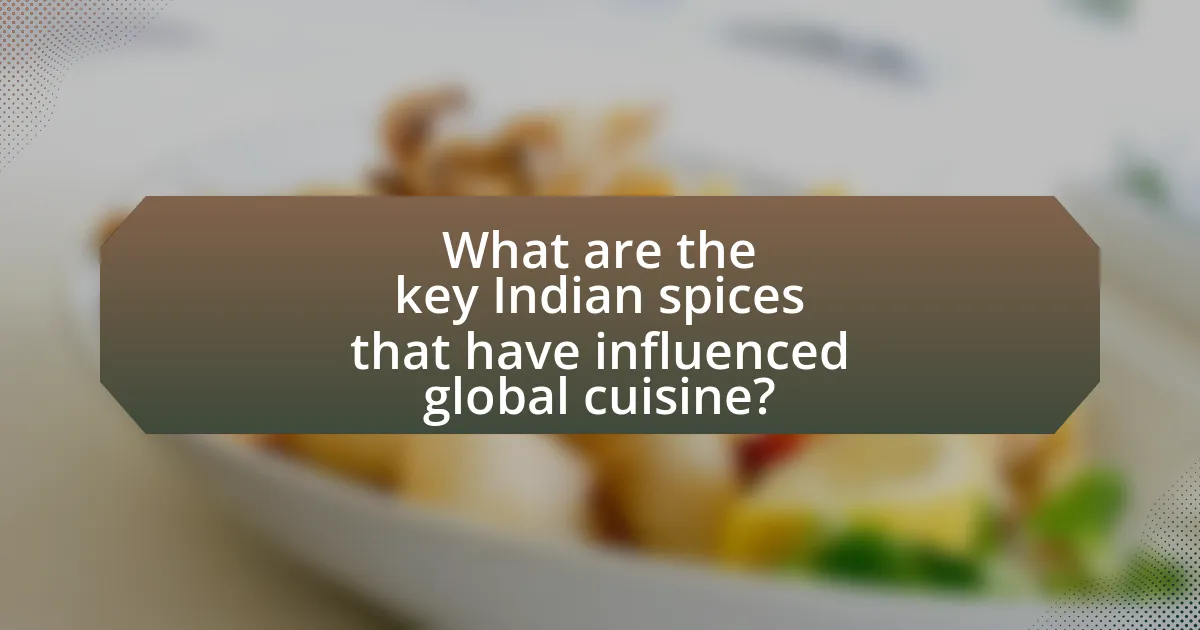The article examines the significant influence of Indian spices on global cuisine, highlighting their unique flavors, health benefits, and integration into various culinary traditions worldwide. Key spices such as turmeric, cumin, and cardamom have transcended regional boundaries, shaping cooking techniques and enhancing dishes across cultures. Historical events, including the Age of Exploration, facilitated the global spread of these spices, while their complex flavor profiles and nutritional advantages have led to their incorporation into modern cooking trends. The article also addresses the challenges chefs face in sourcing authentic spices and offers practical tips for effectively using and storing them in culinary practices.

What is the Influence of Indian Spices on Global Cuisine?
Indian spices significantly influence global cuisine by introducing unique flavors, aromas, and health benefits. Spices such as turmeric, cumin, and cardamom have been integrated into various culinary traditions worldwide, enhancing dishes in regions from Southeast Asia to the Americas. For instance, turmeric is recognized for its anti-inflammatory properties and is now commonly used in Western cooking, particularly in health-conscious recipes. The global popularity of Indian cuisine has led to the incorporation of these spices into mainstream cooking, as evidenced by the rise of curry dishes in British cuisine and the use of garam masala in fusion recipes. This cross-cultural exchange highlights the adaptability and appeal of Indian spices, making them essential components in diverse culinary practices.
How have Indian spices shaped culinary traditions worldwide?
Indian spices have significantly shaped culinary traditions worldwide by introducing unique flavors, enhancing food preservation, and influencing cooking techniques. The global spice trade, particularly during the Age of Exploration, facilitated the spread of spices like turmeric, cumin, and cardamom, which are now integral to various cuisines, from Middle Eastern to Southeast Asian. For instance, turmeric’s anti-inflammatory properties have led to its incorporation in dishes beyond India, such as in curries and health supplements in Western diets. Additionally, the use of spices has transformed food preservation methods, with salt and spices being used to cure meats and vegetables, a practice that has been adopted globally. The historical Silk Road and maritime trade routes further established Indian spices as essential commodities, leading to their integration into local culinary practices and the development of fusion cuisines.
What historical events contributed to the global spread of Indian spices?
The global spread of Indian spices was significantly influenced by the Age of Exploration in the 15th and 16th centuries. During this period, European powers, particularly Portugal and Spain, sought new trade routes to access the lucrative spice markets of India. The Portuguese explorer Vasco da Gama’s voyage to India in 1498 established a sea route that facilitated direct trade between Europe and India, leading to increased demand for spices such as pepper, cardamom, and cinnamon. Additionally, the establishment of colonial empires by the British and Dutch in the 17th century further expanded the trade networks, allowing Indian spices to reach markets across Europe, the Americas, and beyond. The introduction of spices into European cuisine transformed culinary practices and contributed to the global appreciation of Indian flavors.
How do Indian spices differ from spices used in other cuisines?
Indian spices differ from spices used in other cuisines primarily in their complexity and the variety of flavors they offer. Indian cuisine often utilizes a blend of spices, known as masalas, which can include turmeric, cumin, coriander, and cardamom, creating layered flavors that are distinctively aromatic and rich. In contrast, many other cuisines may rely on fewer spices or simpler flavor profiles, focusing on the primary ingredient rather than a complex interplay of spices. For example, Mediterranean cuisine often emphasizes fresh herbs like basil and oregano, while Asian cuisines may use soy sauce or ginger as dominant flavors. The historical context of Indian spices, such as their use in traditional Ayurvedic medicine and their role in trade routes, further enhances their unique characteristics, making them integral to the culinary identity of India.
Why are Indian spices considered essential in various cuisines?
Indian spices are considered essential in various cuisines due to their unique flavors, health benefits, and ability to enhance the overall culinary experience. These spices, such as turmeric, cumin, and coriander, not only add depth and complexity to dishes but also possess medicinal properties that have been recognized for centuries. For instance, turmeric contains curcumin, known for its anti-inflammatory and antioxidant effects, making it a valuable addition to both traditional and modern diets. The global popularity of Indian cuisine has led to the incorporation of these spices into diverse culinary practices, influencing flavors and cooking techniques worldwide.
What flavors and aromas do Indian spices bring to dishes?
Indian spices bring a diverse range of flavors and aromas to dishes, characterized by warmth, complexity, and depth. Spices such as cumin impart earthy notes, while coriander adds a citrusy brightness. Turmeric contributes a warm, slightly bitter flavor and a vibrant yellow color, and cardamom introduces a sweet, floral aroma. Additionally, spices like chili provide heat, and fenugreek offers a slightly sweet, nutty flavor. The combination of these spices creates a harmonious balance that enhances the overall taste profile of dishes, making them rich and aromatic. The use of these spices is rooted in traditional Indian cooking, where they are often blended in specific ratios to achieve desired flavor outcomes, showcasing their integral role in both regional and global cuisines.
How do Indian spices enhance the nutritional value of meals?
Indian spices enhance the nutritional value of meals by providing essential vitamins, minerals, and antioxidants. For instance, turmeric contains curcumin, which has anti-inflammatory properties and may improve heart health. Similarly, cumin is rich in iron, supporting red blood cell production, while coriander offers dietary fiber and aids digestion. The presence of these spices not only boosts flavor but also contributes to overall health benefits, making meals more nutritious. Studies have shown that incorporating spices like ginger and garlic can lower cholesterol levels and improve metabolic health, further validating their role in enhancing meal nutrition.

What are the key Indian spices that have influenced global cuisine?
Key Indian spices that have influenced global cuisine include turmeric, cumin, coriander, cardamom, and chili peppers. Turmeric, known for its vibrant color and health benefits, has become a staple in various cuisines worldwide, particularly in curries and health supplements. Cumin, with its distinct earthy flavor, is widely used in Middle Eastern and Mexican dishes, enhancing the taste of meats and vegetables. Coriander, both in seed and leaf form, adds freshness and is integral to many global recipes, including salsas and spice blends. Cardamom, prized for its aromatic qualities, is essential in both sweet and savory dishes across cultures, from Indian chai to Scandinavian pastries. Chili peppers, originating from India, have transformed global cooking by introducing heat and flavor, becoming a key ingredient in cuisines from Thai to Mexican. These spices not only enhance flavor but also contribute to the health and nutritional profiles of dishes worldwide.
Which Indian spices are most commonly used in international dishes?
Cumin, coriander, turmeric, and cardamom are the Indian spices most commonly used in international dishes. Cumin is widely recognized for its earthy flavor and is often found in Middle Eastern and Mexican cuisines. Coriander, with its citrusy notes, is a staple in various global dishes, including Thai and Indian recipes. Turmeric, known for its vibrant color and health benefits, is increasingly used in Western cooking, particularly in health-focused recipes. Cardamom, prized for its aromatic qualities, is frequently incorporated into both sweet and savory dishes across many cultures, including Scandinavian and Middle Eastern cuisines. These spices have transcended their regional origins, becoming integral to diverse culinary traditions worldwide.
What are the unique characteristics of turmeric and its global applications?
Turmeric is characterized by its vibrant yellow color, distinct earthy flavor, and active compound curcumin, which possesses anti-inflammatory and antioxidant properties. These unique characteristics make turmeric a staple in culinary practices worldwide, particularly in Indian cuisine, where it is used in curries and rice dishes. Globally, turmeric is applied not only as a spice but also in traditional medicine, cosmetics, and food coloring, with the global turmeric market projected to reach approximately $4.5 billion by 2025, reflecting its increasing popularity and diverse applications.
How has the use of cumin evolved in different culinary contexts?
The use of cumin has evolved significantly across various culinary contexts, transitioning from a staple in ancient Indian cuisine to a globally recognized spice. Historically, cumin was utilized in Indian cooking for its flavor and medicinal properties, as documented in texts like the Ayurveda, which dates back over 2,000 years. As trade routes expanded, cumin found its way into Middle Eastern, Mediterranean, and later, European cuisines, where it was incorporated into dishes such as falafel and sauerkraut. In contemporary culinary practices, cumin is now a key ingredient in diverse global cuisines, including Mexican, where it enhances the flavor of tacos and chili, and in American barbecue rubs. This evolution reflects cumin’s adaptability and its integration into various cultural dishes, showcasing its importance in enhancing flavor profiles worldwide.
How do regional variations of Indian spices affect global cuisine?
Regional variations of Indian spices significantly enhance global cuisine by introducing diverse flavors and culinary techniques. For instance, the use of cardamom from Kerala adds a unique sweetness to dishes, while the fiery heat of red chili from Karnataka influences spice levels in international recipes. These regional spices not only enrich the taste profiles of global dishes but also inspire fusion cuisines, such as Indian-Mexican or Indian-Italian, where traditional Indian spices are integrated into local cooking methods. The global popularity of Indian cuisine, evidenced by the rise of Indian restaurants worldwide, showcases the impact of these regional spice variations on culinary trends and preferences.
What role do regional Indian spice blends play in international recipes?
Regional Indian spice blends significantly enhance the flavor profiles of international recipes by introducing complex layers of taste and aroma. These blends, such as garam masala, curry powder, and panch phoron, are characterized by their unique combinations of spices that reflect the diverse culinary traditions of India. For instance, garam masala, which typically includes spices like cumin, coriander, and cardamom, adds warmth and depth to dishes, making it a popular choice in various global cuisines, from British curries to American fusion dishes. The incorporation of these spice blends not only enriches the culinary experience but also promotes the use of spices known for their health benefits, such as anti-inflammatory and antioxidant properties. This integration of Indian spice blends into international recipes illustrates the growing appreciation for Indian cuisine and its influence on global culinary practices.
How do local adaptations of Indian spices differ across cultures?
Local adaptations of Indian spices differ across cultures primarily in their usage, flavor profiles, and preparation methods. For instance, in Southeast Asian cuisines, spices like turmeric and coriander are often used in curries and soups, emphasizing freshness and aromatic qualities, while in Western cuisines, these spices may be incorporated into marinades or sauces, focusing on enhancing meat dishes. Additionally, the level of spice heat varies; for example, Indian cuisine often embraces a higher heat level with chili peppers, whereas in some Western cultures, milder flavors are preferred. This variation is supported by historical trade routes and cultural exchanges, which have influenced how spices are integrated into local culinary traditions, leading to unique adaptations that reflect regional tastes and cooking techniques.

How do Indian spices influence modern culinary trends?
Indian spices significantly influence modern culinary trends by introducing complex flavors and health benefits that enhance dishes worldwide. The use of spices such as turmeric, cumin, and coriander has become prevalent in various cuisines, reflecting a growing interest in bold flavors and health-conscious cooking. For instance, turmeric is recognized for its anti-inflammatory properties, leading to its incorporation in health-focused recipes and products. Additionally, the rise of fusion cuisine showcases how Indian spices are blended with local ingredients, creating innovative dishes that appeal to diverse palates. This trend is supported by the increasing popularity of Indian restaurants and cooking shows, which highlight the versatility and richness of Indian spices, further embedding them into global culinary practices.
What are the current trends in using Indian spices in global cuisine?
Current trends in using Indian spices in global cuisine include the increasing incorporation of spices like turmeric, cumin, and cardamom into mainstream dishes, reflecting a growing consumer interest in health benefits and flavor diversity. The rise of plant-based diets has also led to a surge in the use of Indian spices to enhance the taste of vegetarian and vegan meals, as evidenced by the popularity of Indian-inspired dishes in restaurants worldwide. Additionally, the global market for spices is projected to grow significantly, with a report from Research and Markets indicating a compound annual growth rate of 4.5% from 2021 to 2026, highlighting the expanding role of Indian spices in culinary practices across various cultures.
How are chefs incorporating Indian spices into fusion cuisine?
Chefs are incorporating Indian spices into fusion cuisine by blending traditional Indian flavors with global culinary techniques and ingredients. For example, turmeric is being used in salad dressings and marinades, while garam masala is featured in tacos and burgers, enhancing the flavor profile of these dishes. This trend reflects a growing appreciation for the complexity of Indian spices, as evidenced by the increasing popularity of dishes like curry-infused risotto and chai-spiced desserts. The incorporation of these spices not only adds depth but also introduces health benefits associated with their anti-inflammatory properties, making fusion cuisine both flavorful and nutritious.
What impact do Indian spices have on health-conscious cooking?
Indian spices significantly enhance health-conscious cooking by providing flavor and nutritional benefits without the need for excessive salt or fat. Spices such as turmeric, known for its anti-inflammatory properties due to curcumin, and cumin, which aids digestion, contribute to overall health. Research published in the Journal of Medicinal Food highlights that spices can improve metabolic health and reduce the risk of chronic diseases. Additionally, the use of spices can promote the consumption of vegetables and whole grains, aligning with dietary guidelines that emphasize plant-based foods for better health outcomes.
What challenges do chefs face when using Indian spices in global cuisine?
Chefs face several challenges when using Indian spices in global cuisine, primarily due to the complexity of flavor profiles and the need for precise balancing. Indian spices often have strong, distinct flavors that can overwhelm dishes if not used correctly, making it essential for chefs to understand the nuances of each spice. Additionally, the availability and quality of authentic Indian spices can vary significantly in different regions, leading to inconsistencies in flavor and authenticity. For instance, spices like saffron or cardamom may not be as fresh or potent outside of India, affecting the overall dish quality. Furthermore, chefs must navigate cultural perceptions and preferences, as some diners may be unfamiliar with or resistant to the bold flavors typical of Indian cuisine, which can limit the acceptance of dishes that incorporate these spices.
How can chefs overcome the challenges of sourcing authentic Indian spices?
Chefs can overcome the challenges of sourcing authentic Indian spices by establishing direct relationships with reputable suppliers and utilizing online platforms that specialize in Indian ingredients. Direct relationships with suppliers ensure access to high-quality, genuine spices, as these suppliers often have established connections with farmers in India, guaranteeing authenticity. Online platforms like Spice Jungle and Penzeys Spices provide a wide range of authentic Indian spices, often sourced directly from India, which helps chefs avoid counterfeit products. Additionally, chefs can attend trade shows and food expos focused on Indian cuisine to network with suppliers and learn about new sourcing options. This approach not only enhances the authenticity of their dishes but also supports sustainable sourcing practices.
What techniques can be used to balance the flavors of Indian spices in diverse dishes?
To balance the flavors of Indian spices in diverse dishes, techniques such as layering spices, adjusting acidity, and incorporating sweetness are essential. Layering spices involves adding them at different stages of cooking to develop depth, while adjusting acidity with ingredients like lemon juice or tamarind can counteract excessive heat from spices. Incorporating sweetness through ingredients like sugar or coconut milk can also help to mellow strong flavors. These methods are supported by culinary practices in Indian cuisine, where achieving a harmonious balance is crucial for flavor development.
What practical tips can enhance the use of Indian spices in cooking?
To enhance the use of Indian spices in cooking, toasting the spices before use is highly effective. This process releases essential oils, intensifying their flavors and aromas. For instance, toasting cumin seeds or coriander seeds in a dry pan for a few minutes can significantly elevate the taste of a dish. Additionally, using whole spices instead of pre-ground ones ensures fresher flavors, as ground spices lose potency over time. Furthermore, incorporating spices at the right stage of cooking, such as adding them early for deeper flavor integration or towards the end for a more pronounced taste, can also enhance the overall dish. These methods are supported by culinary practices in Indian cuisine, where the careful handling of spices is crucial for achieving authentic flavors.
How can home cooks effectively store and use Indian spices?
Home cooks can effectively store Indian spices by keeping them in airtight containers, away from light and moisture, to preserve their potency. Spices such as turmeric, cumin, and coriander should be stored in a cool, dark place, as exposure to heat and sunlight can degrade their flavor and aroma. Additionally, using whole spices instead of ground ones can enhance shelf life; whole spices can last for several years, while ground spices typically last about six months to a year. To use Indian spices effectively, home cooks should toast whole spices in a dry pan before grinding or adding them to dishes, as this releases essential oils and intensifies their flavors. This method is supported by culinary practices in Indian cooking, where toasting spices is a common technique to enhance the overall taste of the dish.
What are some common mistakes to avoid when cooking with Indian spices?
Common mistakes to avoid when cooking with Indian spices include using stale spices, which diminishes flavor, and not toasting whole spices before use, as this enhances their aroma and taste. Additionally, failing to balance spices can lead to overpowering flavors; for instance, using too much chili powder can overshadow other spices. Not understanding the proper cooking times for different spices can also result in bitterness or a lack of depth in flavor. Lastly, neglecting to adjust spice levels based on personal preference can lead to dishes that are either too bland or too spicy, making it essential to taste and adjust throughout the cooking process.
